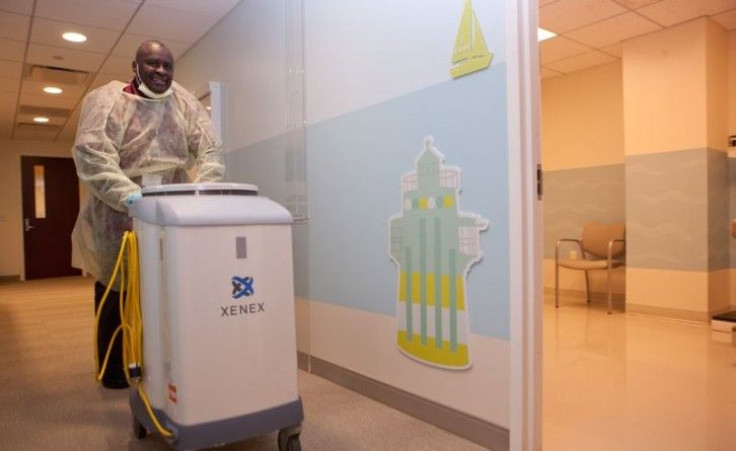'Little Moe,' Ebola-Killing Robot, Destroys Viruses Using Extreme UV Rays, But How Safe Are Said UV Rays?

Due to the infectious nature of the disease, experts from the Centers for Disease Control and Prevention are taking all available steps to ensure the first confirmed Ebola diagnosis in the United States does not spread past the quarantine zone. “Little Moe,” the Ebola-killing robot that is already being used at Texas Health Presbyterian Hospital in Dallas where the first Ebola case was detected and treated, could prove to be an effective tool in containing the spread of the Ebola virus. Now, is it safe?
Developed by San Antonio-based Xenex, Little Moe may seem like it's straight out of a science fiction movie, but it is already being used at 250 hospitals across the U.S. Dubbed the “germ-zapping robot,” this unique piece of medical equipment emits ultraviolet rays that are approximately 25,000 times brighter than the sun. Blasting 1.5 pulses per second, while covering a radius of up to 10 feet, it can destroy viral DNA from any surface it comes in contact with.
“Eliminating pathogens from patient rooms is the quickest and easiest way to lower the risk of additional infections,” Dr. Mark Stibich, co-founder and chief scientific officer of Xenex, said in a statement. “Our customers report in peer-reviewed, published studies that after using our patented germ-zapping robots to disinfect surfaces, they experienced significant reductions in hospital acquired infections. That’s because our devices are faster, more effective, and easier to use than mercury-based UV room disinfection systems.”
To set itself apart from other UV disinfection methods, Xenex developed its germ-zapping robot using the inert non-toxic gas xenon as opposed to mercury. This not only makes for a safer UV solution, but also a quicker one. Xenex representatives vow that Little Moe’s use of xenon can destroy the DNA of other infectious diseases in five minutes and Ebola in two minutes, compared to mercury-based systems, which can take up to an hour.
“Our customers have proven that they can reduce C. diff and MRSA infection rates by more than 50 percent by using our robots for surface disinfection,” Stibich added. “Only Xenex’s broad spectrum UV light is capable of damaging microorganisms four different ways and ensuring the pathogens are destroyed. We believe in evidence-based medicine and challenge anyone considering UV room disinfection to look at the science behind the competing technologies before making a decision. Not all UV light is the same, and our patented pulsed xenon technology has truly set itself apart.”
The safety and effectiveness of Little Moe’s xenon-based UV technology is already being praised by health care professionals specializing in radiology. “This definitely looks promising, especially for doctors who continually work in the areas where an infectious disease like Ebola can spread,” Dr. Sanjay Jain, board certified physician and bestselling author, told Medical Daily. “Xenon is already used safely in the field of nuclear medicine. During lung ventilation/profusion scans, also known as VQ scans, it is inhaled by the lungs to help diagnose a pulmonary embolism. I am interested to see how this technology develops.”



























